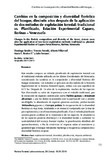Mostrar el registro sencillo del ítem
Cambios en la composición y diversidad florística del bosque, dieciséis años después de la aplicación de dos métodos de explotación forestal: tradicional vs. Planificado, Estación Experimental Caparo, Barinas – Venezuela
| dc.rights.license | http://creativecommons.org/licenses/by-nc-sa/3.0/ve/ | es_VE |
| dc.contributor.author | Sánchez P., Domingo A. | |
| dc.contributor.author | Arends, Ernesto | |
| dc.contributor.author | Villarreal, Alberto | |
| dc.contributor.author | Benítez, María E. | |
| dc.contributor.author | Serrano P., Julio C. | |
| dc.date.accessioned | 2018-07-04T18:08:31Z | |
| dc.date.available | 2018-07-04T18:08:31Z | |
| dc.date.issued | 2018 | |
| dc.identifier.issn | 0798-2437 | es |
| dc.identifier.uri | http://www.saber.ula.ve/handle/123456789/45099 | |
| dc.description.abstract | Este estudio compara un método planificado de explotación forestal con el tradicional método utilizado en los Llanos Occidentales de Venezuela, considerando los cambios en la composición y diversidad florística del bosque remanente. Los métodos se aplicaron en dos rodales de la Estación Experimental de la Reserva Forestal Caparo, ambos con una superficie de 62,5 ha. Después de 16 años de la explotación, muchas de las especies han disminuido su valor de importancia con el método tradicional, por la extracción de especies comerciales como Pachira quinata y Brosimum alicastrum, y por los daños ocasionados con la apertura de vías y arrastre no dirigido; la abundancia de especies pioneras aumenta, predominando Trichanthera gigantea y Cecropia peltata; la recuperación de la diversidad florística es muy lenta, tendiendo a ser menor al compararla con la fase de pre-explotación y con el tratamiento planificado. Con el método planificado ocurren pocos cambios en la importancia de las especies; la abundancia de las especies pioneras disminuye y la diversidad tiende a aumentar. La sustentabilidad del manejo forestal implica la planificación detallada del aprovechamiento, a fin de minimizar el impacto sobre el ecosistema y garantizar que el bosque remanente mantenga o recupere su composición y diversidad florística original. | es_VE |
| dc.language.iso | es | es_VE |
| dc.publisher | Saber-ULA | es_VE |
| dc.rights | info:eu-repo/semantics/openAccess | es_VE |
| dc.subject | Explotación forestal | es_VE |
| dc.subject | Diversidad | es_VE |
| dc.subject | Planificación | es_VE |
| dc.subject | Impacto ambiental | es_VE |
| dc.title | Cambios en la composición y diversidad florística del bosque, dieciséis años después de la aplicación de dos métodos de explotación forestal: tradicional vs. Planificado, Estación Experimental Caparo, Barinas – Venezuela | es_VE |
| dc.title.alternative | Changes in the floristic composition and diversity of the forest, sixteen years after the application of two forest exploitation methods: traditional vs. planned, Experimental Station of Caparo Forest Reserve, Barinas, Venezuela | es_VE |
| dc.type | info:eu-repo/semantics/article | es_VE |
| dcterms.dateAccepted | 20/11/2013 | |
| dcterms.dateSubmitted | 18/08/2013 | |
| dc.description.abstract1 | This study compares a method of planning of the forest exploitation with the traditional method used in the Western Plains of Venezuela, on the base of the changes in the floristic composition and species diversity of the remnant forest. The methods were applied in two stands of the Experimental Station of Caparo Forest Reserve, both with a surface of 62,5 ha. After 16 years of logging, many species have decreased their importance value with the traditional method, because the removal of commercial species such as Pachira quinata and Brosimum alicastrum, and for damage caused due to opening of roads and undirected drag; the abundance of pioneer species increases, predominating Trichanthera gigantea and Cecropia peltata; recovery of the diversity is very slow, tending the diversity to be minor compared with the pre-exploitation phase and the planned treatment. With the planned method of exploitation few changes occur on the importance of the species; the abundance of pioneer species decreases and floristic diversity tends to increase. Sustainability of forest management involves the detailed planning of the forest harvesting, in order to minimize the impact on the ecosystem and ensure that the remnant forest maintains or recovers its original floristic composition and diversity. | es_VE |
| dc.description.colacion | 13-26 | es_VE |
| dc.description.email | dosan@ula.ve | es_VE |
| dc.description.email | earends@ula.ve | es_VE |
| dc.description.email | alvi@ula.ve | es_VE |
| dc.description.email | jserrano@ula.ve | es_VE |
| dc.identifier.depositolegal | 198102ME433 | es |
| dc.publisher.pais | Venezuela | es_VE |
| dc.subject.facultad | Facultad de Ciencias Forestales y Ambientales | es_VE |
| dc.subject.institucion | Universidad de Los Andes | es_VE |
| dc.subject.institutoinvestigacion | Instituto Forestal LatinoAmericano (IFLA) | |
| dc.subject.keywords | Forest exploitation | es_VE |
| dc.subject.keywords | Diversity | es_VE |
| dc.subject.keywords | Planning | es_VE |
| dc.subject.keywords | Environmental impact | es_VE |
| dc.subject.publicacionelectronica | Revista Forestal Latinoamericana | |
| dc.subject.seccion | Revista Forestal Latinoamericana: Articulos | es_VE |
| dc.subject.thematiccategory | Geografía | es_VE |
| dc.subject.tipo | Monografías | es_VE |
| dc.type.media | Texto | es_VE |
Ficheros en el ítem
Este ítem aparece en la(s) siguiente(s) colección(ones)
-
Revista Forestal Latinoamericana - Vol 028 - Nº 53-54
Enero - Diciembre 2013


